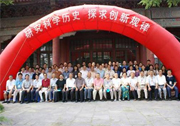| 英文摘要: |
In ancient China, people were used to measuring cubage by units of length, and to describing cubage by a length. Wang Rongbin and Li Jimin showed a method by which the ancient Chinese measured cubage. This paper shows a new method of measurement previously unknown to modern scholars: in order to describe cubage, ancient Chinese supposed that it was transformed into a right quadrangular prism, of which the base was a square with the side of 1 chi, while the length of the height was used to describe the value of the cubage. This measurement method could avoid confusion of quantities in calculations, was easy for most junior officers to learn and to master, and could fit the urgent need of timeliness in military activities. This new finding is significant for the understanding of ancient Chinese mathematics, measurement systems, and the interpretation of ancient historical literature. |





